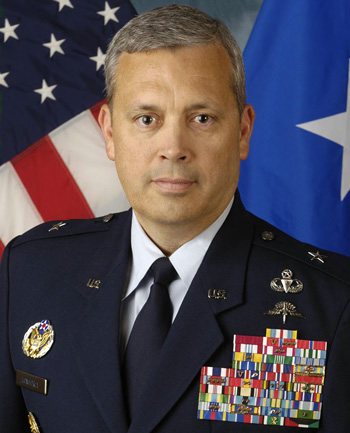
|
Michael A. Longoria |
 |
|||
| Rank, Service | ||||
Brigadier General O-7, U.S. Air Force |
||||
| Veteran of: | ||||
|
||||
| Tribute: | ||||
Michael Longoria was born on December 14, 1955, in Houston, Texas. He entered the U.S. Air Force Academy in June 1975, and graduated with a commission as a 2d Lt on May 30, 1979. Lt Longoria remained at the academy as an advisor to the Registrar for Minority Affairs from June 1979 to June 1980, and then completed his special operations combat control training schools in June 1982. He served as a combat controller with the 1st Special Operations Wing at Hurlburt Field, Florida, from June 1982 to November 1983, followed by service as chief of the Combat Control and Pararescue Division with Headquarters 23rd Air Force at Scott AFB, Illinois, from November 1983 to June 1986. During this time he also served as commander of the Pararescue Military Freefall Training Team from November 1985 to June 1986. His next assignment was as chief of the Combat Analysis Division at Scott AFB from June 1986 to November 1988, and then as operations officer for the 1723rd Combat Control Squadron at Hurlburt Field from November 1988 to June 1991. During this time, Maj Longoria served in Operation Just Cause in Panama from December 1989 to January 1990, and in Operation Desert Shield and Desert Storm in Southwest Asia from August 1990 to April 1991. He attended Naval War College at Newport, Rhode Island, from June 1991 to June 1992, and then attended the School of Advanced Airpower Studies at Maxwell AFB, Alabama, from June 1992 to June 1993. His next assignment was at the Pentagon, where he served as a politico-military officer in the Strategy Division with the Deputy Chief of Staff for Air and Space Operations with Headquarters U.S. Air Force from June 1993 to June 1994, followed by service as special military advisor on Cuban Affairs for the Secretary of Defense from June to November 1994. Col Longoria served as director of Democracy Issues on the National Security Council Staff at the White House from November 1994 to June 1995, and then was commander of the 23rd Combat Control Squadron at Pope AFB, North Carolina, from June 1995 to June 1996. His next assignment was as commander of the 21st Special Tactics Squadron at Pope AFB from June 1996 to June 1997, followed by an assignment was a National Defense Fellow in Washington, D.C., from July 1997 to July 1998. He was next assigned to the Office of the Secretary of Defense where he served as assistant for Special Reconnaissance from July 1998 to September 1999, and then director of Combating Terrorism from September 1999 to September 2000. Col Longoria served as special assistant to the Commander of U.S. Special Operations Command at MacDill AFB, Florida, from September 2000 to July 2001, followed by service as commander of the 18th Air Support Operations Group at Pope AFB from July 2001 to January 2003. During this time he served in support of Operation Enduring Freedom in Afghanistan from December 2001 to June 2002. His next assignment was as commander of the 484th Air Expeditionary Wing during Operation Iraqi Freedom from January to August 2003, and then as deputy director for Plans and Programs with Headquarters Air Combat Command at Langley AFB, Virginia, from September 2003 to August 2004. He served as director of the Joint Air/Ground Combat Office with Headquarters Air Combat Command at Langley AFB from August 2004 to December 2005, and then served as commanding general of the Joint Interagency Task Force with Multi-National Force-Iraq, in Baghdad, Iraq, from January to September 2006. Gen Longoria was special assistant for Air Force Cyber Command issues with Headquarters Air Combat Command from December 2006 to October 2007, and then served as commander of Detachment 5 with Headquarters 9th Air Force at Moody AFB, Georgia, from October 2007 to January 2008. His final assignment was as commander of the 93rd Air Ground Operations Wing at Moody AFB from January 2008 until his retirement from the Air Force on October 1, 2009. |
||||
|
||||

